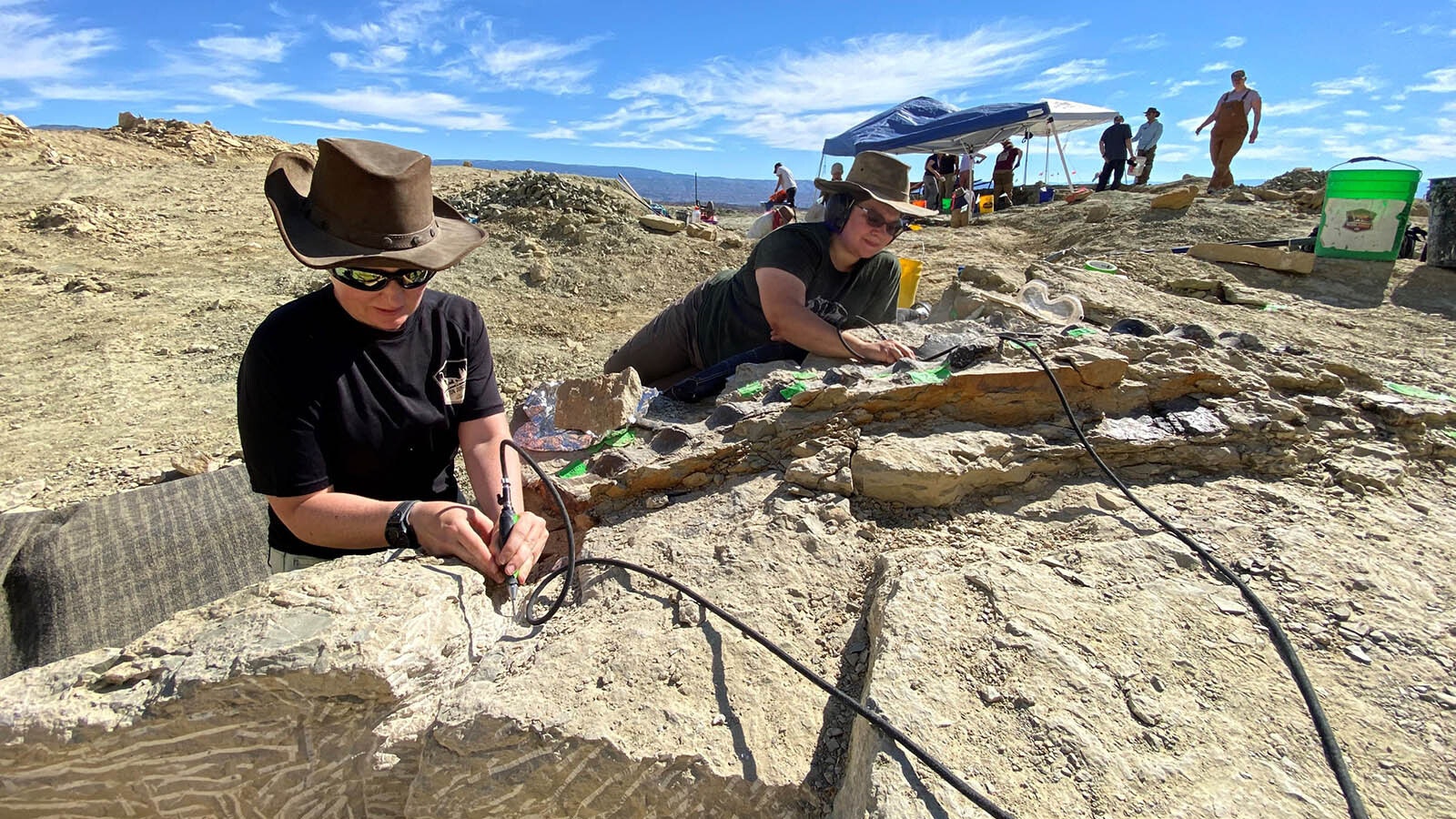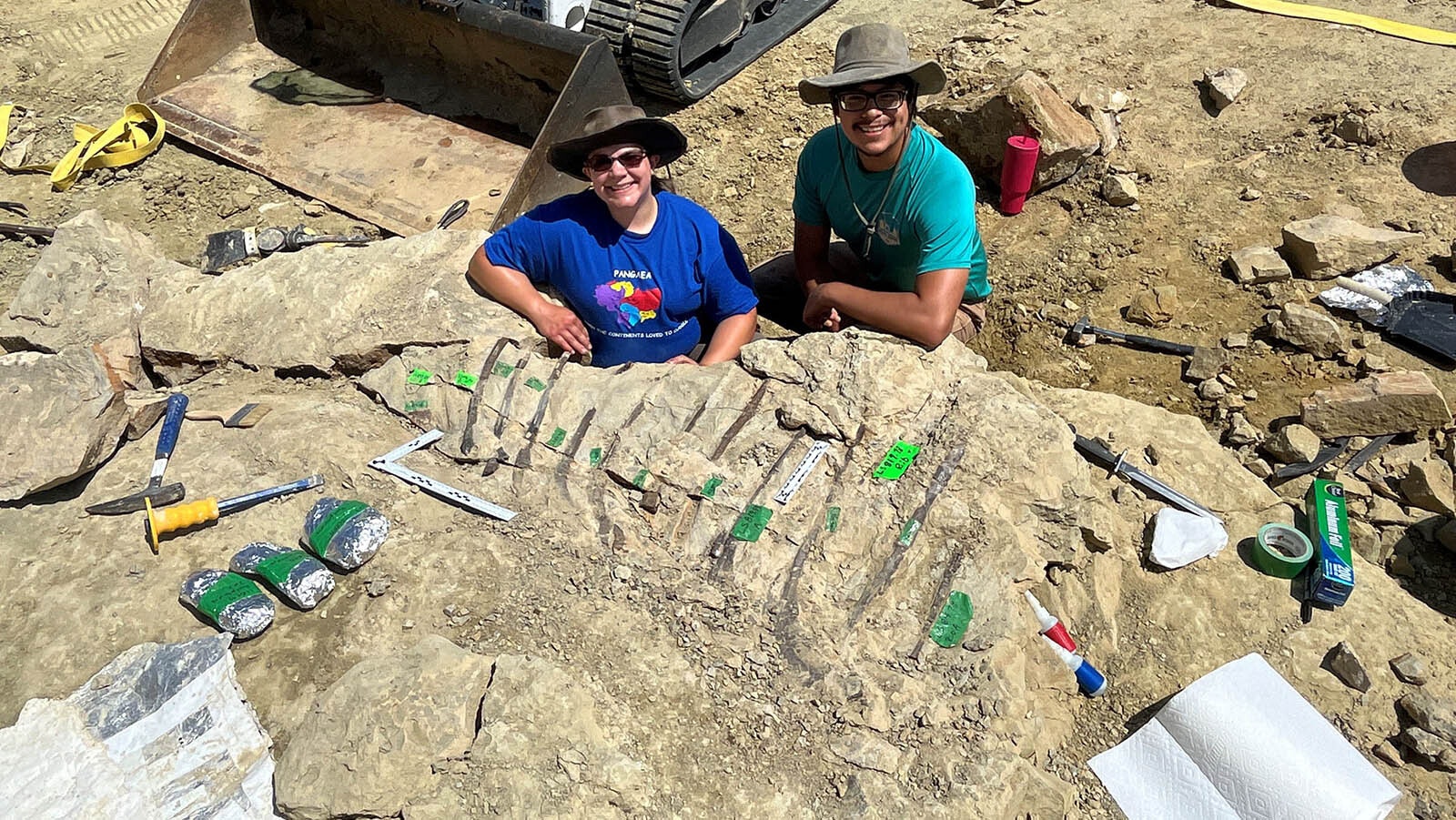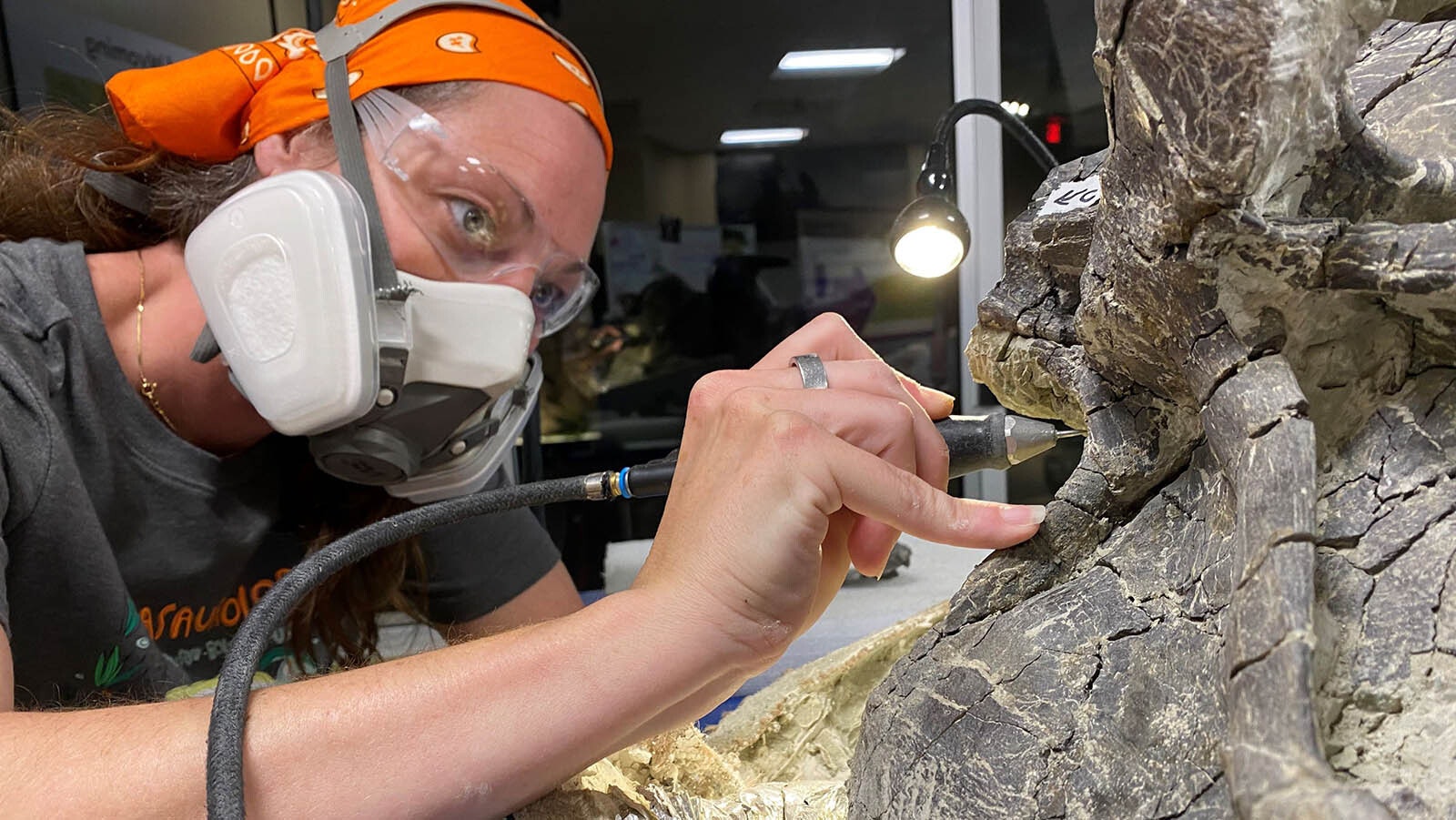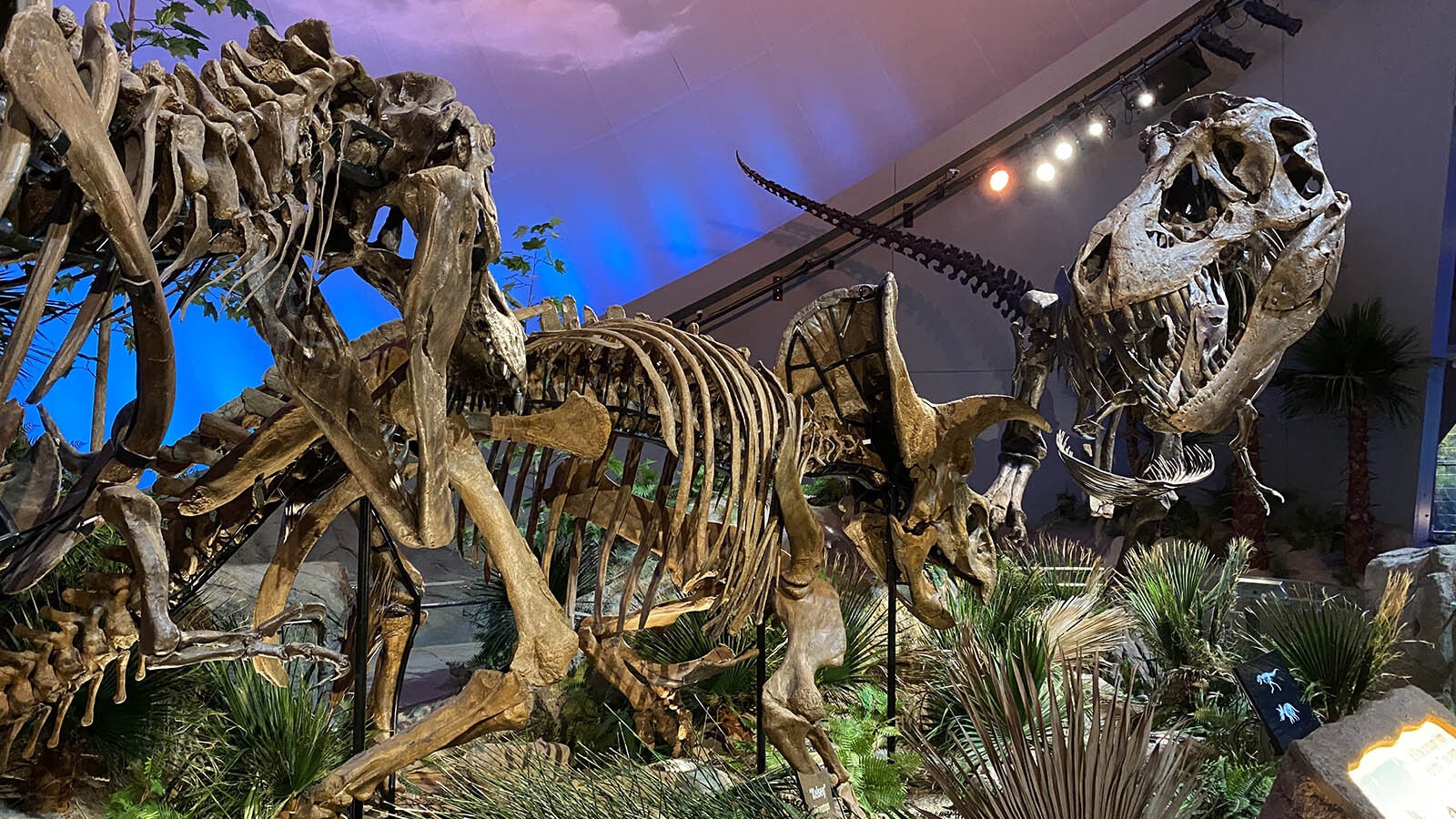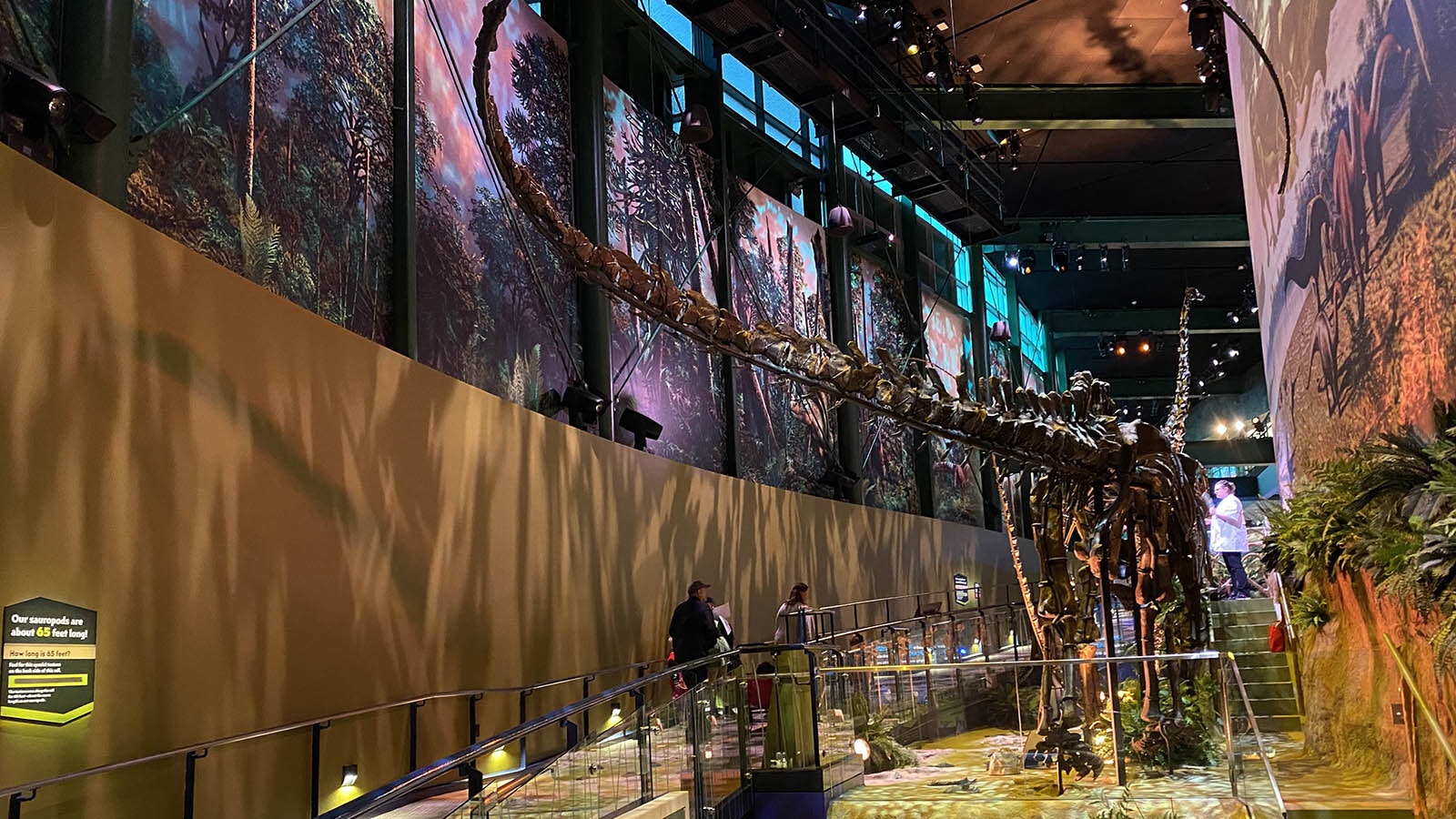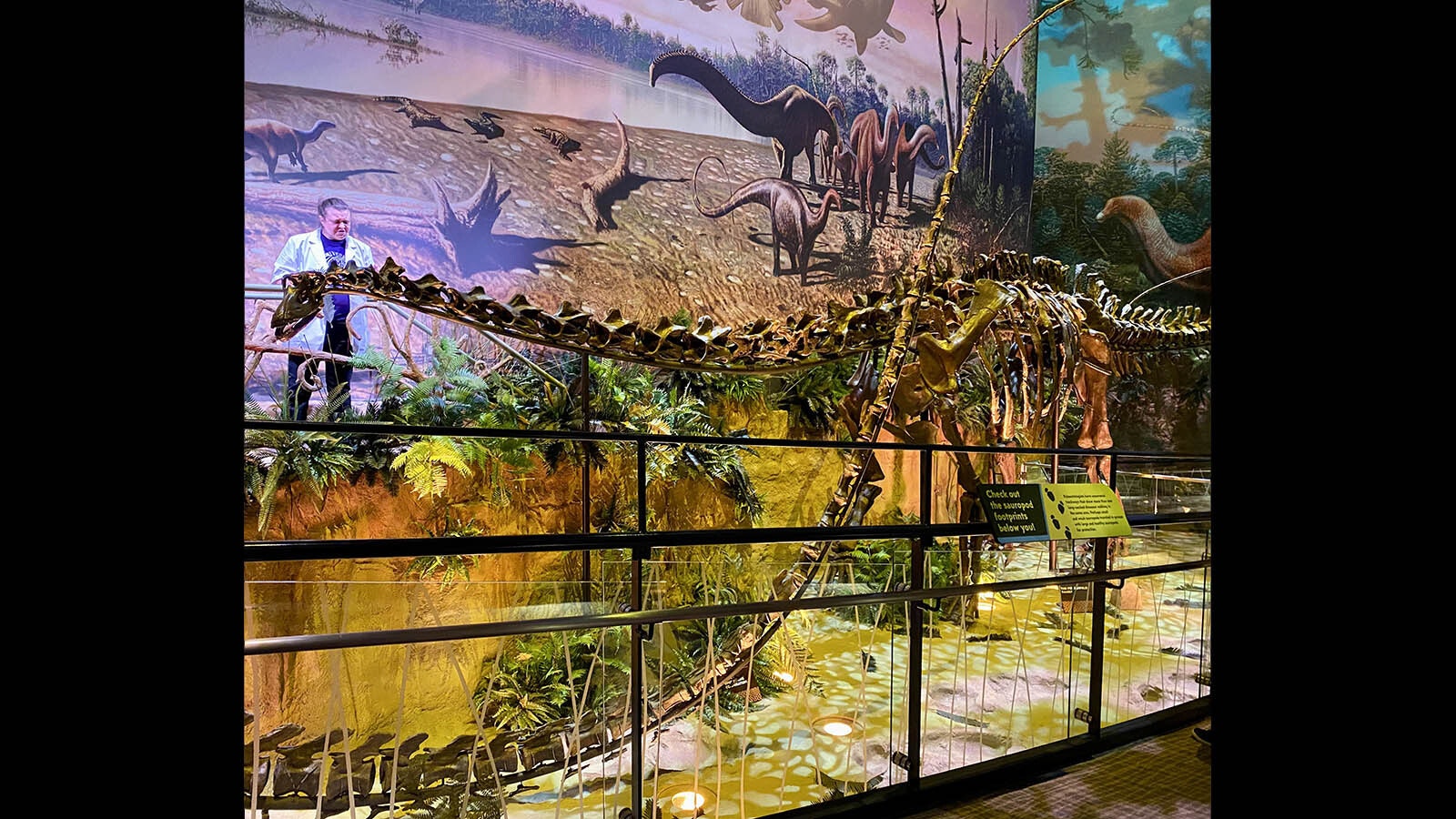Paleontologists at the Children’s Museum of Indianapolis are getting plenty of mileage out of their ongoing work on the Jurassic Mile near Shell, and their current project shows they’ve got plenty of skin in the game.
The newest exhibit outside the museum’s fossil preparation lab is a block of rock containing the lower leg bones of an Allosaurus, the ferocious Late Jurassic predator that roamed Wyoming around 150 million years ago.
But this Allosaurus is more than a pair of nice legs. It’s another discovery that makes the Jurassic Mile the gift that keeps on giving.
“We've been digging in this area since 2017,” said Laura Rooney, curator of paleontology at the Children's Museum. “And we see no stopping anytime soon. It's kept us very happy the whole time.”
A Dark Spot
Rooney has been excavating dinosaur fossils at the Jurassic Mile for years. She helped find bones from two giant long-necked sauropods, which are already on display at the museum.
In 2020, the fossils of the long necks were still being removed from the rock. An excavator was brought in to remove the rock and soil sitting on top of the fossil-producing layer.
“We never expected to find anything in those particular layers,” Rooney told Cowboy State Daily. “But when one scoop came out, we saw a little glimpse of something darker in color, a little bit shiny. We told the excavators to stop and let us take a look.”
The darker, shiny spot was a chunk of dinosaur bone.
It’s not unusual for an exciting discovery to start with an excavator finding a piece out of place, but further excavation (by hand) revealed something extraordinary.
“All of the pieces were just lying there perfectly in one big block,” Rooney said. “That was the first sign that we had something pretty cool here.”
The big block contained the legs and feet of an Allosaurus. But all the bones, from the delicate toes to the long lower and upper legs, were connected as they would’ve been when the dinosaur was alive, something paleontologists call articulation.
That wasn’t all. As Rooney and the rest of the team kept digging, they realized they could be finding all of an Allosaurus.
“There is a good chunk more of the dinosaur that is articulated,” she said. “We know we have a majority of the tail, the ribs and hips of this animal, as well as the neck and part of the sacrum.”
While it may have been articulated in the field, the blocks containing the articulated Allosaurus are now in multiple pieces in the museum’s fossil preparation lab. Visitors can peer through the windows and watch fossil preparators at work using dental picks and air tools to remove tiny bits of hard rock from the black fossils underneath the surface.
Skin And Bones
Everyone gets excited about a new dinosaur skeleton, but paleontologists are most excited when they find articulated skeletons. Finding an intact dinosaur is a sign its body was buried quickly after it died without much dismemberment from water, decay or scavengers.
Articulated skeletons also mean a chance of preserved skin. Several “dinosaur mummies” with skin impressions stretched across their bare bones like a giant reptilian zombie have been found in Wyoming.
The Jurassic Mile’s Allosaurus is showing a lot of skin in areas where impressions have never been found before. Rooney said they’ve identified skin impressions around the legs, but also the hips, chest and neck of their Allosaurus.
“Some skin impressions from Allosaurus had been found before,” Rooney said, “but not in the particular area of the animal that we have them preserved. This is helping expand our knowledge of the appearance of the scales in different areas of these dinosaurs' bodies.”
Rooney is also excited about several pathologies identified on the skeleton. Dinosaurs didn’t have doctors, so any traumatic injury that didn’t kill them (immediately) slowly and crudely healed.
Determining how a dinosaur died can be almost impossible, but pathologies can tell paleontologists how they lived. That’s why Rooney’s so excited to see the gnarled bones of this Allosaurus.
“We have several pathologies or injuries on our dinosaur,” she said. “These things happened during this animal's life, and it survived. Learning about what this animal's life would have been like through the story that those injuries and healed injuries tell. It’s really cool to see.”
It’s A Small World
While work on the articulated Allosaurus continues in the fossil preparation lab, paleontologists have dozens of other fossils to study. Dr. Joseph Frederickson, lead paleontologist and manager of the museum’s Natural Science Collection, said the small fossils from the Jurassic Mile could lead to the biggest discoveries.
“The Jurassic Mile is a pretty special place,” he said. “Everything from the tiniest little animals to the biggest ones in that ecosystem are preserved there. There are quite a few active projects and papers being worked on.”
Some “smaller discoveries” include fossils from small dinosaurs, lizard-like reptiles, plant impressions and rare Late Jurassic fish. They’ve even found footprints from other dinosaurs that walked through the area near the fossilized remains of their deceased kin.
“The Jurassic Mile is an active research site,” he said. “And there's a lot of research that still needs to be done.”
Corpulent Carnivore
Rooney and Frederickson are also enthused about another articulated section of the Jurassic Mile’s Allosaurus. The skeleton includes the rarely found gastralia, or its “belly ribs.”
Those run along the abdomen of many reptiles, like crocodiles and dinosaurs, and support the abdominal muscles. Think of it like a bony six-pack.
Rooney said finding an articulated string of belly ribs could add a lot of weight to this Allosaurus.
“Gastralia just aren't well known from these dinosaurs,” she said. “Finding gastralia from animals like T. rex taught us that T. rex is fat. Our Allosaurus gastralia could give us a bit more of an idea of the dimensions of this animal and just a better view of what they might have looked like.”
Heading In The Right Direction
The legs, tail, ribs, belly ribs and neck of this Allosaurus are all articulated and well-preserved. So, if all those pieces are there, where’s the head?
Rooney said the Allosaurus’ mind is split. Half is at its new home in Indianapolis, while the other half is wintering in the Cowboy State.
“The block of our of the Allosaurus skull and neck is in our lab, but one pretty noticeable part of it that's missing is its snout,” she said. “We still have that snout back in the ground in Wyoming. We know it's there, and we will rescue that snout and reunite it with the rest of the skull. That’s our big plan for this summer.”
Rooney and Frederickson said their summers in Wyoming are “the best time of the year.” They long to resume their excavations this summer, where the perfect-age prehistoric rocks and stunning vistas are a welcome break from the flatness of Indiana, a stare utterly devoid of dinosaurs.
“(Wyoming) is a gorgeous place to work,” Rooney said. “It's always fun to go, returning to our home away from home every summer.”
But there’s more than just a snout waiting in the rocks of the Jurassic Mile. After so many successful seasons of fossil excavation, it’s possible the best discoveries are yet to be made.
“There's more to come,” Frederickson said. “This site will keep us busy for a very long time, and it won't be the last you'll hear about the Jurassic Mile.”
Andrew Rossi can be reached at arossi@cowboystatedaily.com.


